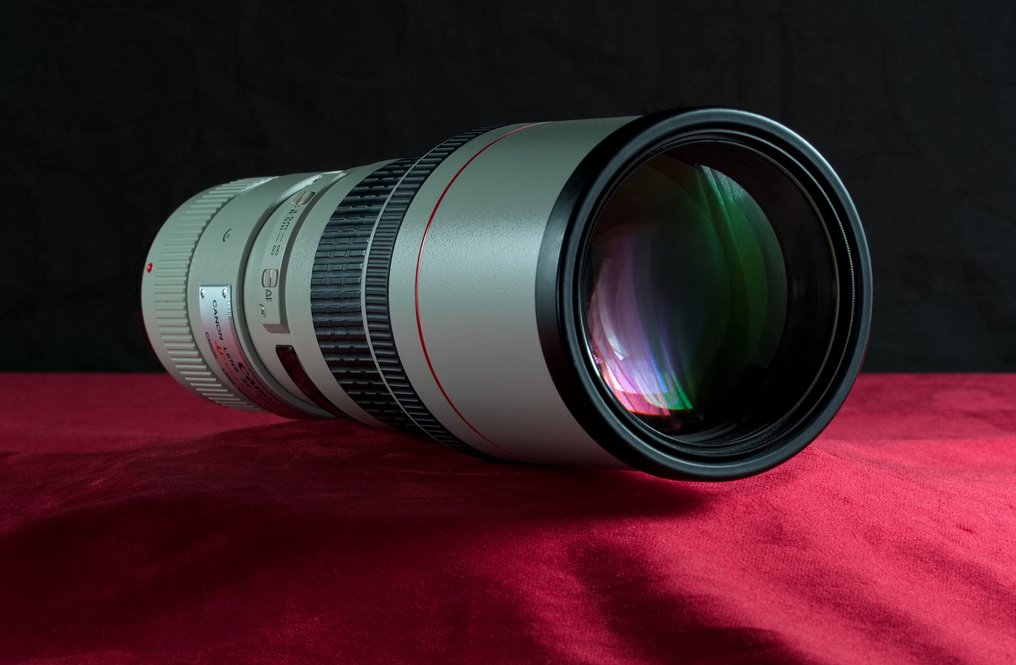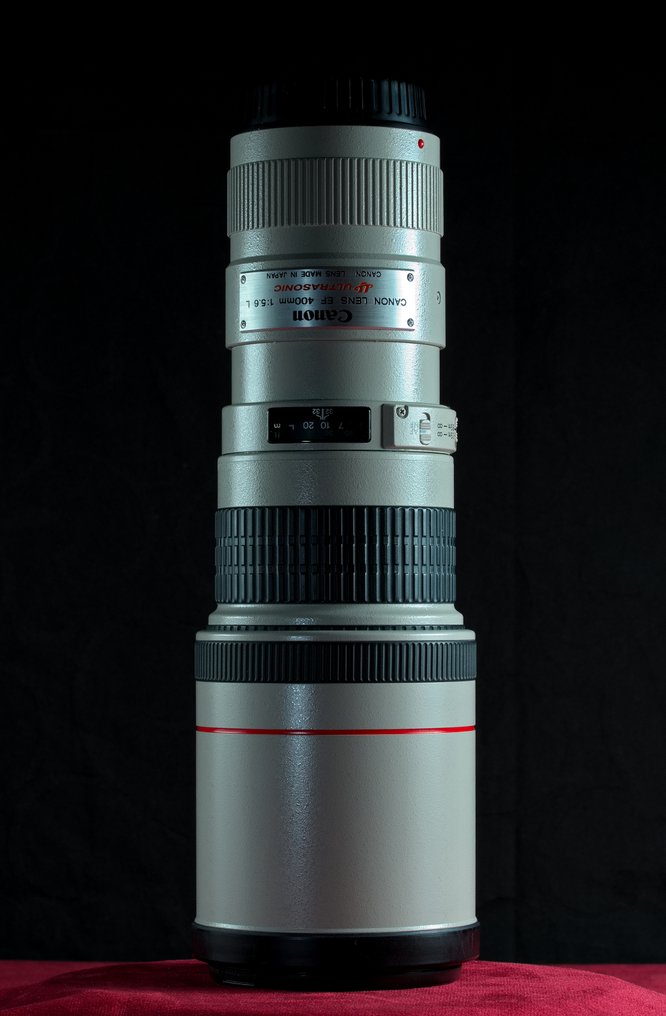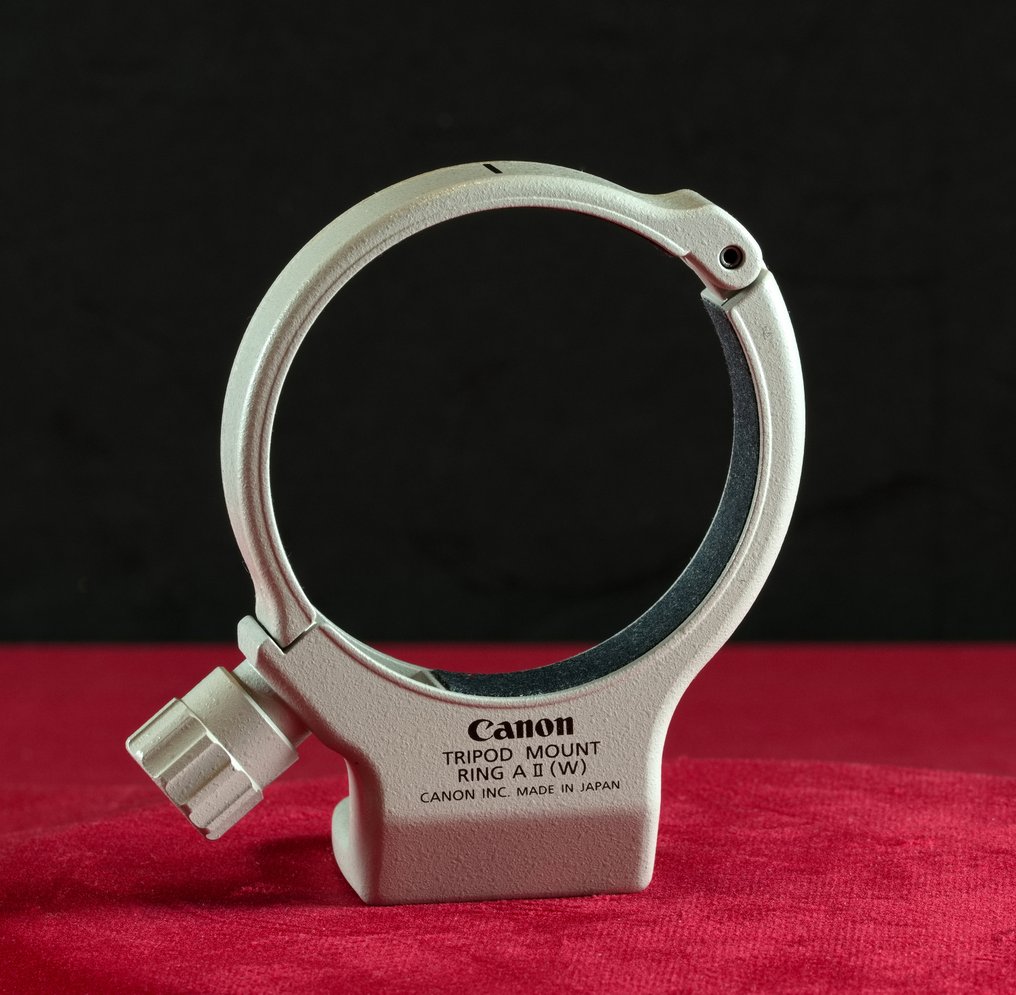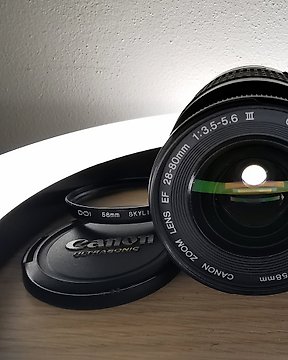
Canon EOS 2000D + EF-S 18-55 III Digital reflex camera (DSLR)
Catawiki is continuously updating its technology. You are currently using an outdated browser. To optimise your browsing experience, please update your browser.
You can set your cookie preferences using the toggles below. You can update your preferences, withdraw your consent at any time, and see a detailed description of the types of cookies we and our partners use in our Cookie Policy.
No. 84487791





Canon EF 400 F5.6 L USM + Accessories
Professional wildlife-, birding- and sports telephoto lens with superb optics, in mint condition
Canon has produced many telephoto lenses over the years, of which the EF 400 F5.6 L USM is the lightest (only 1.25 kg), which is absolutely not noticeable in the design or optical quality.
This 400 mm telephoto lens can easily be worn all day, is weather sealed and offers incredibly good quality, both in sharpness and contrast. This lens is no longer produced new, mainly due to the fact that it does not offer IS. I have rarely found this to be a problem and, with the rapid development of cameras that perform well at high ISO values, it is becoming less and less of a disadvantage.
The EF 400 F 5.6 L is entirely made of metal with some rubber elements, 'built like a tank' and made in Japan. The date of manufacture code that can be read on this beautiful specimen is UZ 1220, which means that the lens was manufactured in (probably August) 2011 in Canon’s Utsunomiya plant. I bought the lens new in 2012. The lens hood is attached to the camera and can be turned to let it keep its position.
The lens has 7 elements in 6 groups. One element is of UD glass, and another is of Super UD glass, designed to increase sharpness and eliminate color fringes. You won’t see distortion or chromatic aberration in the pictures made with this lens.
The aperture has 8 blades, resulting in a beautiful ‘bokeh’.The filter size of the front element is 77mm. Choosing a good quality UV filter is not only important for optical quality, but also to protect against damage to the front lens element. That is why I have included a Hoya HD UV filter, which I have always had on the lens. The same applies to the protective lens coat in camouflage colors (why are high-quality telephoto lenses for wildlife so often white?). The lens coat is made specifically for this lens and can be put on and taken off quite easily.
The lens focuses quickly and almost silently thanks to the USM motor, which focuses internally and is very precise, which also makes this lens very suitable for capturing birds in flight; the focus is always spot-on. To get the best results, use a centre focus point surrounded by a small cluster of points.
You can use the 400 mm on both full frame and crop cameras (APS-C), which alters the range considerably (on an APS-C camera the focal length becomes 640 mm). For use on a full frame Canon, I purchased the (supplied) Kenko teleconverter, which increases the focal length to 560 mm. Although the resolution remains more than reasonable with the Kenko, it does become difficult to use: the addition causes a light reduction of 1 stop, which practically results in a maximum aperture of 8.0. The use of a tripod or monopod in such cases is recommended.
The Kenko teleplus (short for Kenko C-AF 1.4X Teleplus MC4 DGX) is a high quality teleconverter. You can read this (German) test report, in which it gets an ‘excellent’ rating.
https://www.traumflieger.de/objektivtest/open_test/telekonverter/overview.php
The box with the lens comes with all (mentioned) accessories and of course the original lens caps, the easily moveable tripod mount ring, a Hoya HD 77 mm UV-filter, a padded LZ 1132 lens case, a tailored protective lens coat with camouflage colors in 3 parts and the Kenko C-AF 1.4X Teleplus MC4 DGX teleconverter, which comes in a pouch. There is some software on a cd as well, but I doubt if that has any added value.
Some additional tips and recommendations:
use both focus rings for even quicker fine tuning of focus; the use of a macro ring can reduce the standard minimum focusing distance (3.5 m); although the lens performs very well wide open, choosing a 7.1 or 8.0 aperture will still noticeably enhance the quality with more clarity. Use the 3.5-infinity focus setting so you don’t have to switch too often; the autofocus is fast enough for this.
You (still) can’t buy this quality for under € 2000!
It’s smarter to invest in a highly suitable modern APS-C body (like the EOS R7) than to buy an expensive zoom with a greater reach (like the 200-800mm). This lens will keep its great value.
You can pick up the lens from the Netherlands or have it sent to you by either PostNL or DHL.
Canon EF 400 F5.6 L USM + Accessories
Professional wildlife-, birding- and sports telephoto lens with superb optics, in mint condition
Canon has produced many telephoto lenses over the years, of which the EF 400 F5.6 L USM is the lightest (only 1.25 kg), which is absolutely not noticeable in the design or optical quality.
This 400 mm telephoto lens can easily be worn all day, is weather sealed and offers incredibly good quality, both in sharpness and contrast. This lens is no longer produced new, mainly due to the fact that it does not offer IS. I have rarely found this to be a problem and, with the rapid development of cameras that perform well at high ISO values, it is becoming less and less of a disadvantage.
The EF 400 F 5.6 L is entirely made of metal with some rubber elements, 'built like a tank' and made in Japan. The date of manufacture code that can be read on this beautiful specimen is UZ 1220, which means that the lens was manufactured in (probably August) 2011 in Canon’s Utsunomiya plant. I bought the lens new in 2012. The lens hood is attached to the camera and can be turned to let it keep its position.
The lens has 7 elements in 6 groups. One element is of UD glass, and another is of Super UD glass, designed to increase sharpness and eliminate color fringes. You won’t see distortion or chromatic aberration in the pictures made with this lens.
The aperture has 8 blades, resulting in a beautiful ‘bokeh’.The filter size of the front element is 77mm. Choosing a good quality UV filter is not only important for optical quality, but also to protect against damage to the front lens element. That is why I have included a Hoya HD UV filter, which I have always had on the lens. The same applies to the protective lens coat in camouflage colors (why are high-quality telephoto lenses for wildlife so often white?). The lens coat is made specifically for this lens and can be put on and taken off quite easily.
The lens focuses quickly and almost silently thanks to the USM motor, which focuses internally and is very precise, which also makes this lens very suitable for capturing birds in flight; the focus is always spot-on. To get the best results, use a centre focus point surrounded by a small cluster of points.
You can use the 400 mm on both full frame and crop cameras (APS-C), which alters the range considerably (on an APS-C camera the focal length becomes 640 mm). For use on a full frame Canon, I purchased the (supplied) Kenko teleconverter, which increases the focal length to 560 mm. Although the resolution remains more than reasonable with the Kenko, it does become difficult to use: the addition causes a light reduction of 1 stop, which practically results in a maximum aperture of 8.0. The use of a tripod or monopod in such cases is recommended.
The Kenko teleplus (short for Kenko C-AF 1.4X Teleplus MC4 DGX) is a high quality teleconverter. You can read this (German) test report, in which it gets an ‘excellent’ rating.
https://www.traumflieger.de/objektivtest/open_test/telekonverter/overview.php
The box with the lens comes with all (mentioned) accessories and of course the original lens caps, the easily moveable tripod mount ring, a Hoya HD 77 mm UV-filter, a padded LZ 1132 lens case, a tailored protective lens coat with camouflage colors in 3 parts and the Kenko C-AF 1.4X Teleplus MC4 DGX teleconverter, which comes in a pouch. There is some software on a cd as well, but I doubt if that has any added value.
Some additional tips and recommendations:
use both focus rings for even quicker fine tuning of focus; the use of a macro ring can reduce the standard minimum focusing distance (3.5 m); although the lens performs very well wide open, choosing a 7.1 or 8.0 aperture will still noticeably enhance the quality with more clarity. Use the 3.5-infinity focus setting so you don’t have to switch too often; the autofocus is fast enough for this.
You (still) can’t buy this quality for under € 2000!
It’s smarter to invest in a highly suitable modern APS-C body (like the EOS R7) than to buy an expensive zoom with a greater reach (like the 200-800mm). This lens will keep its great value.
You can pick up the lens from the Netherlands or have it sent to you by either PostNL or DHL.








